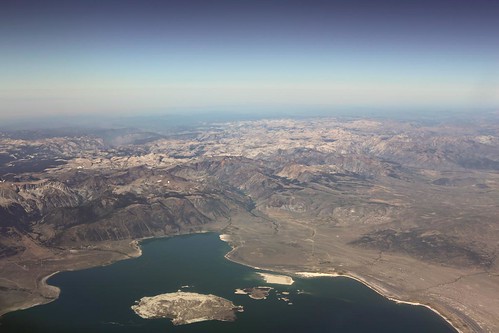OK... so in my last post I said I didn't want to edit any more through the window photos for a long time. Well, this morning I got this shot as we passed over Mono Lake, California, and I liked it enough to spend 45 minutes editing it tonight.
Here's a breakdown of my aerial photo editing process using CS3:
1) Convert to LAB color
2) Create two curves adjustment layers -- one of them I use to adjust lightness/contrast and the other to adjust color. I play back and forth between the two layers, a contrast adjustment might reveal the photo is too green so I slide towards red in my color correction curves layer. After the color is correct I am then able to really crank up the contrast without making the sky look like a green and yellow mess.
3) Once the color and contrast is correct I create a third curves adjustment layer where I crank up the color saturation (the LAB color way) by evenly steepening the a and b channels curves. I completely overdue this layer and dial back the layer opacity until the saturation looks correct.
4) After flattening the above layers I create a duplicate layer and do some heavy duty noise reduction. By this point in the editing process noise has been created in areas with no texture or details (in this photo the lake had a lots of noise in it). If the noise is really bad I revert to Gaussian Blur at 1.5 pixel radius. I then completely mask the noise reduction layer and brush through the mask at the problem areas; sky and lake in this pic
5) Flatten the image again, create a new layer, select the lightness channel only, and sharpen at amount 20 radius 50 and threshold zero. Once again completely mask the layer and brush in the areas that need more sharpness. In this picture I brushed in the mountains and area around the lake.
That's it... you're done. If you have fancy supercharged computer (I don't) you can substitute all the image flattening with merge visible (ctrl+alt+shift+E) and keep the layers separate till the end. If I ran things that way my old compaq would crash or start on fire. Also, you can avoid some of the color correcting problems by shooting in raw and fixxing color in te RAW converter. My hard drive is too full for me to shoot RAW. Maybe I'll do some house cleaning tomorrow.
Wednesday, September 3, 2008
Mono Lake and the Sierras
Subscribe to:
Post Comments (Atom)


1 comment:
Really nice paper work.Image editing encompasses the processes of altering images, whether they be digital photographs, traditional analog photographs, or illustrations.
Regards,
Graphics@sbl
clipping path services
Post a Comment